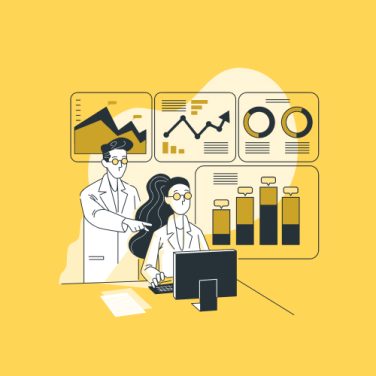Predictive analytics sits at the nexus of traditional HRIS operations and the evolution of people analytics platforms. As HR data volumes grow, integrating analytics capabilities directly into HRIS platforms ensures seamless access to forecasts without exporting data to external systems.
HR predictive analytics tools blend statistical methods with machine learning to forecast workforce trends such as turnover risk, absenteeism spikes, and performance trajectories. Embedding predictive modules within HR workflows reduces manual effort, accelerates insights, and supports data-driven talent planning.
MiHCM Data & AI brings predictive insights into MiHCM solutions. Pre-built models for absenteeism clustering, turnover scoring, and performance forecasting appear alongside payroll and talent management workflows, empowering HR directors to act on forecasts without leaving their core system.
Key takeaways
- HR predictive analytics enables forecasting of attrition, performance, and recruitment outcomes.
- Embedding predictive models into HRIS reduces data silos and speeds decision-making.
- Top tools range from specialised platforms to embedded modules such as MiHCM Data & AI.
- Successful implementation requires addressing data quality, privacy, and ethical challenges.
Core methodologies of HR predictive analytics tools

Predictive analytics differs from descriptive reporting (what happened) and diagnostic analysis (why it happened) by forecasting future events. In HR, predictive analytics uses algorithms to identify patterns that precede turnover, high performance, or absenteeism.
- Regression Analysis: Estimates relationships between variables, e.g., tenure and turnover risk.
- Classification: Assigns employees to risk categories (high/medium/low) for attrition using logistic regression or decision trees.
- Clustering: Groups employees by behaviours, such as leave-pattern clusters to predict absenteeism spikes.
- Machine Learning: Uses random forests, gradient boosting, or neural networks to refine predictions as data evolves.
Common predictive use cases in HR include:
- Turnover risk scoring for targeted retention programs
- Identifying high-potential employees for succession planning
- Forecasting absenteeism to optimise staffing levels
People analytics platforms operationalise these models by integrating data preprocessing, feature engineering, and visual dashboards. For instance, MiHCM Data & AI leverages tenure, engagement scores, and competency ratings to generate risk scores within its dashboards, eliminating the need for manual model tuning.
By combining automated model retraining, explainability modules, and stakeholder alerts, HR teams can trust predictions and integrate insights into talent management processes.
Key use cases: Attrition, performance, and recruitment
Attrition prediction: Attrition prediction models analyse factors such as tenure, job satisfaction, and compensation changes to score each employee’s risk of leaving. Scores trigger alerts for managers to intervene with tailored retention strategies.
- Inputs: engagement survey results, promotion history, manager ratings
- Output: risk score 0–100, hotspots by department or location
- Benefit: reduces voluntary turnover by up to 20%
Performance Forecasting: Early performance indicators—completion rates, peer feedback, training hours—feed regression models to predict future high performers. HR leaders use this for succession planning and targeted development.
Recruitment Analytics: Predictive recruitment models forecast time-to-hire and candidate success probabilities. By evaluating resume features, interview scores, and sourcing channels, teams allocate resources to high-yield pipelines.
- Predicted time-to-hire helps set realistic SLAs
- Candidate success probability informs offer prioritisation
- Integration with ATS ensures continuous model improvement
Absenteeism Modelling: Historical leave data clusters identify patterns—seasonal spikes, department-specific trends—to forecast absenteeism rates. MiHCM’s absenteeism dashboards highlight peak leave months, enabling staffing adjustments in advance.
Data requirements and best practices for predictive modelling
Successful HR predictive analytics depends on robust data pipelines and rigorous model governance.
| Aspect | Best Practices | Tools/Notes |
|---|---|---|
| Data Sources | HRIS, ATS, LMS, payroll, performance systems | Unified via ETL or API |
| Data Quality | Normalisation, deduplication, missing value imputation | Use data profiling tools |
| Feature Engineering | Create tenure, engagement, competency metrics | Leverage Python/R libraries |
| Compliance & Privacy | Anonymise PII, track consent, implement access controls | GDPR, CCPA frameworks |
| Model Governance | Version control, explainability reports, bias audits | MLflow, DataRobot |
Key practices include scheduling retraining after significant workforce changes, validating models on holdout samples, and involving stakeholders in feature selection to ensure transparency. Adhering to GDPR and CCPA regulations protects employee data—anonymisation and consent tracking are non-negotiable.
Stakeholder buy-in is crucial. Regular reviews with HR leaders and IT ensure the models align with organisational objectives and ethical standards.
Integration with HR systems and workforce planning
Integrating predictive analytics tools with HRIS, payroll, and ATS systems ensures a unified data ecosystem and drives strategic workforce planning.
- Connect via APIs or ETL pipelines to ingest real-time data.
- Build unified dashboards that overlay predictive outputs (e.g., turnover risk) with headcount and budget metrics.
- Use scenario modelling to simulate headcount needs under different attrition rates or hiring velocity.
- Conduct skills gap analysis by comparing forecasted demand with internal competency inventories.
End-to-end integration reduces manual exports and consolidates insights in a single pane for HR directors. MiHCM Data & AI’s seamless link to MiHCM HRIS automates data synchronisation, ensuring forecasts reflect the latest workforce changes.
Benefits include faster strategic reviews, reduced spreadsheet errors, and the ability to pivot resources based on predictive scenarios in real time.
Challenges, privacy, and ethical considerations

Implementing HR predictive analytics tools requires careful attention to bias mitigation, privacy, and change management.
- Algorithmic Bias: Training data may reflect historical biases; conduct bias audits and use fairness metrics.
- Employee Trust: Provide transparent model explanations and opt-in consent mechanisms to maintain confidence.
- Privacy Regulations: Enforce data anonymisation, consent tracking, and role-based access controls in compliance with GDPR and CCPA.
- Change Management: Train HR teams on analytics literacy and embed data champions to foster a data-driven culture.
- Ethical AI Frameworks: Adopt risk mitigation processes such as impact assessments and governance committees.
Balancing innovation with ethical safeguards ensures predictive analytics serves both organisational goals and employee rights.
Implementing predictive analytics with MiHCM Data & AI
- Data Ingestion: Connect MiHCM Data & AI to your HRIS and payroll modules via built-in integration wizards.
- Model Configuration: Select pre-built templates for absenteeism clustering, turnover scoring, performance forecasting, and recruitment metrics.
- Dashboard Setup: Customise predictive dashboards to display key metrics and alerts for HR stakeholders.
Unlocking workforce insights with predictive analytics
HR predictive analytics tools transform workforce management from reactive to proactive. By integrating predictive models within HRIS, organisations gain accurate attrition forecasts, recruitment insights, and performance projections.
- Ensure data quality, ethical modelling, and robust integrations.
- Embed analytics in daily HR workflows for seamless insights.
- Continuously monitor model performance and update features.
Explore MiHCM Data & AI for embedded predictive capabilities directly within your HRIS. For a comprehensive overview, consult our Ultimate Guide to HR Analytics Tools.



